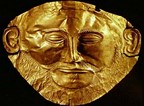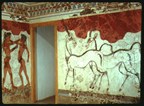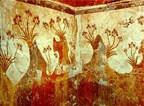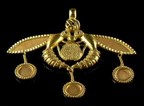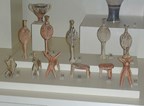The Mycenaean civilization was also known as Achaean civilization. Their civilization was the cultural period of the Bronze Age. Pylos, Corinth and Mycenae were independent city states were the strongest among the Mycenaean civilization. Mycenae was a city of Agamemnon (one of those leaders who defeated Troy.) the city states were ruled by kings. They had their palaces built on hilltops which were enclosed with giant walls, in case of attack; these walls helped them to defend. Mycenae was one of the dominating cities in the Peloponnese with their impressive gate of the Lions; they had huge palaces which were replicated in many parts of the Greece. The history of Mycenaean civilization is very rich. This civilization was known for their jewelry designs which are still stored in the National Archaeological Museum located in Athens. Apart from jewelry, other ornaments and artifacts are also displayed. According to Mycenaean civilization, the people of this civilization were literate and educated, they wrote in a script known as the Linear B. Apart from Greece, some traces of the Mycenaean civilization can also be found in Egypt, North Syria and Asia.
Around 1200 BC the fall of the Mycenaean civilization began. The fall of this great civilization was known as the Dark Age. According to the Mycenaean civilization history, the Dark Age included declining in population and declining of the settlements. The Mycenaean civilization began spreading widely around 1600BC. This civilization advanced by conquest unlike Minoans who advanced with trade. The Mycenaean civilization had defeated Minoans and captured their lands. Archaeologists got to know a lot about the history of the Mycenaean civilization when they discovered their buried Nobel in beehive tombs. The beehive tombs were large circular cylinder shaped burial chambers with a high vaulted roof and a straight passage. The nobles were burned with masks made of gold, along with crowns, tiara, weapons embossed with jewelry and armors. The process of burying the Noble was that they were mummified and were buried in a sitting position.
According to linear scripts found of the Mycenaean civilization, it has been discovered that economy of this civilization was very simple. The first group of people used to work around the palace while others were just self-employed, that is they had their own businesses. The economy of Mycenaean civilization was supervised by authorized scribes, these scribes used to make notes of all the trading, importing and exporting of the products. They also used to note which man is doing which job, to whom was the specific assigned and who was in charge of distributions of rations. The territory of the Mycenaean kingdoms was divided into Pylos and Knossos. One was the palace and another was the communal land. The agriculture on these lands included grains, olives and grapes. The grain cultivated were whet and barleys, while olives were planted for regular use and also for the production of oil. The Mycenaean civilization was known for their olives as they used oil in food products and also as lotions, body oils and scented perfumes. Grapes were cultivated in large lands and with different varieties. They were widely used in production of wine as well which was very commonly used by the leaders of the Mycenaean civilization. Other agricultural good the Mycenaean civilization grew to be flax, sesame, figs and other trees. The flax was used for the lining of clothing. Mycenaean civilization was also very much involved in livestock farming. Their livestock mainly consists of goats and sheep because mutton was eaten widely. The number of cows and pigs were very few and horses were only used for pulling chariots in battles or for traveling of higher authorities. The horses were bred well and were kept in excellent condition.
The Mycenaean civilization had a special workforce; each worker belonged to a specific category and was assigned to specific places in the stage of production (which was all basically related to textiles). Textile was one of the principal sectors of the economy. The entire chain of production from the flock of the sheep to the stocking of the store rooms present in the palace, sorting of wools, shearing all was don’t in the workshops. There were 145 different types of textile in Mycenaean civilization, 550 textile workers worked in the palace of Pylos while 900 worked in Knossos. The Mycenaean civilization was very much involved in the metal industry. The smith used to make jewelry of bronze gold and other metals. They also used to make weapons such as swords, bows and archers. According to the history, Mycenaean was experts in making perfumes, artifacts and jewelries (which can still be found in different museums across the entire Greece land).
The timings of the end of Mycenaean civilization are still left unknown. There were various reasons for their civilization to an end. The first being destruction. It had been noted that civilization’s population started to decline after earthquakes and floods occurred in the kingdoms. Many people had died and settlements were completely destroyed. The Mycenaean sites started to decrease in the Greece (as read in the ancient scripts return in the Mycenaean civilization time period. Many people of the Mycenaean civilization had migrated to other places because they felt insecure and then there was an invasion by Dorians and Sea people. Many cities were sacked. The fall of this civilization was declared as a dark age as the population declined, literate people left their places and migrated to Cyprus, because they had migrated the script was left unwritten. The Dorians had risen during 1100 BC; they were the local people and were taking over Mycenaean civilization while Sea people had completely destroyed Territory and palaces in Pylos. There was a huge climate change in 1100 as well. The area of Mycenaean civilization had suffered long term drought as well. The drought caused agriculture to be affected and there was a shortage of food. This led people to search for food in other areas of the Greece land.
